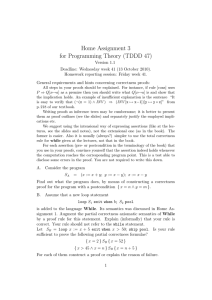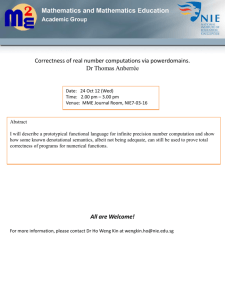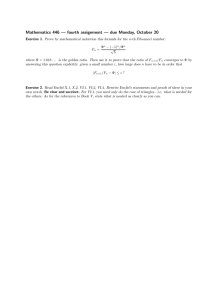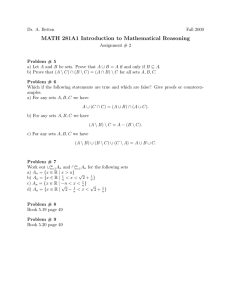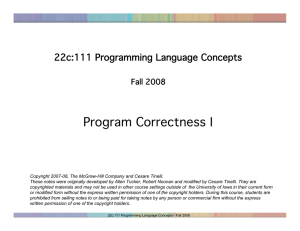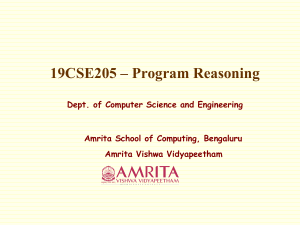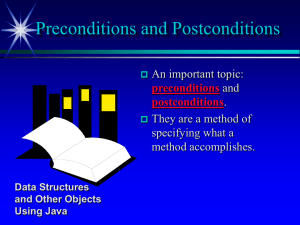Home Assignments 3 for Programming Theory (TDDA 43)
advertisement
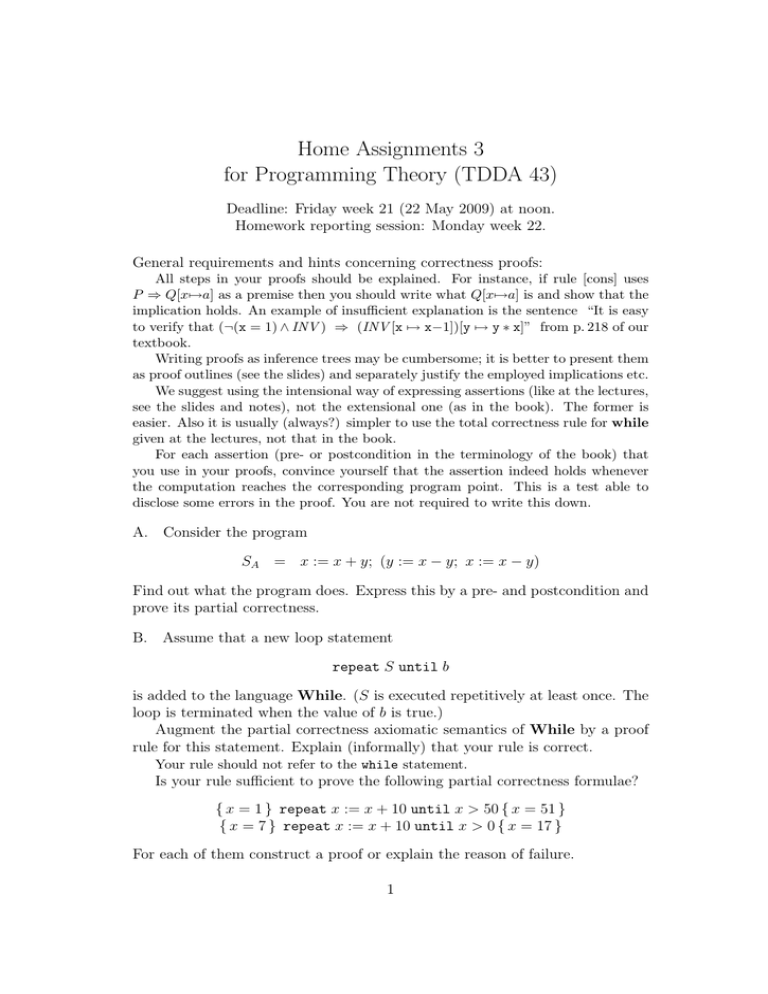
Home Assignments 3
for Programming Theory (TDDA 43)
Deadline: Friday week 21 (22 May 2009) at noon.
Homework reporting session: Monday week 22.
General requirements and hints concerning correctness proofs:
All steps in your proofs should be explained. For instance, if rule [cons] uses
P ⇒ Q[x7→a] as a premise then you should write what Q[x7→a] is and show that the
implication holds. An example of insufficient explanation is the sentence “It is easy
to verify that (¬(x = 1) ∧ INV ) ⇒ (INV [x 7→ x−1])[y 7→ y ∗ x]” from p. 218 of our
textbook.
Writing proofs as inference trees may be cumbersome; it is better to present them
as proof outlines (see the slides) and separately justify the employed implications etc.
We suggest using the intensional way of expressing assertions (like at the lectures,
see the slides and notes), not the extensional one (as in the book). The former is
easier. Also it is usually (always?) simpler to use the total correctness rule for while
given at the lectures, not that in the book.
For each assertion (pre- or postcondition in the terminology of the book) that
you use in your proofs, convince yourself that the assertion indeed holds whenever
the computation reaches the corresponding program point. This is a test able to
disclose some errors in the proof. You are not required to write this down.
A. Consider the program
SA = x := x + y; (y := x − y; x := x − y)
Find out what the program does. Express this by a pre- and postcondition and
prove its partial correctness.
B. Assume that a new loop statement
repeat S until b
is added to the language While. (S is executed repetitively at least once. The
loop is terminated when the value of b is true.)
Augment the partial correctness axiomatic semantics of While by a proof
rule for this statement. Explain (informally) that your rule is correct.
Your rule should not refer to the while statement.
Is your rule sufficient to prove the following partial correctness formulae?
{ x = 1 } repeat x := x + 10 until x > 50 { x = 51 }
{ x = 7 } repeat x := x + 10 until x > 0 { x = 17 }
For each of them construct a proof or explain the reason of failure.
1
C. Find a precondition Pt under which program
SC
= while ¬(x = 100) do x := x + y
terminates, and a precondition Pl under which the program loops. Prove the
non-termination by proving partial correctness { Pl } SC { false }. Prove the
termination by proving total correctness { Pt } SC { ⇓ true }.
Each precondition should imply that y > 1. Each precondition should allow
infinitely many distinct values of x.
If you find this problem too easy, here is a more ambitious version. Replace the
program by
y := 0; while x 6= y do (y := y + 1; x := x + y).
You may use S(n) to denote the sum Σni=1 i = (n + 1)n/2.
D. 1. Let F (i) denote the i-th Fibonacci number. (The first two Fibonacci
numbers are F (1) = F (2) = 1, the remaining ones are defined by F (i) =
F (i − 2) + F (i − 1), for i = 3, 4, . . ..) Construct, together with a total
correctness proof, a program establishing the postcondition
Q = ∃i : F (i) < n ≤ F (i + 1) = y
In other words, the program produces y which is the first Fibonacci number not smaller than the given number n. Use P = (n > 1) as the
precondition. (The program should not change the value of n.)
Hints: Add x = F (i) to Q in order to obtain the postcondition of the
loop in the program. (This is a design decision – to keep the previous
Fibonacci number in x.) Obtain the loop invariant by weakening the
postcondition. Find a reasonable bound function z; construct the loop
body so that it decreases z (in other words, comes closer to the solution)
and preserves the invariant.
2. Introduce an error to your program and explain why it now cannot be
proven correct. Try to use a kind of error that often happens in programming.
Put your solutions, addressed to Jonas Wallgren, in the “Post till IDA” slot at
Café Java. Keep a copy of your solutions for the homework reporting session.
Your answers may be in English or Swedish.
It is allowed to discuss the exercises with others, but you are supposed to
solve each exercise individually. It is absolutely not allowed to copy solutions
from others.
The maximal marks for the problems A, B, C and D are, respectively, 2, 3,
3 and 7 (with 5 for the more difficult version of C). To pass you need at least
8 points.
2
